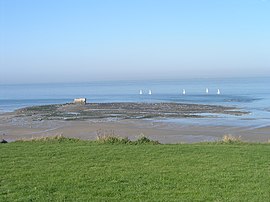Le Portel
| Le Portel | |
|---|---|

Fort de l'Heurt
|
|
| Coordinates: 50°42′27″N 1°34′28″E / 50.7075°N 1.5744°ECoordinates: 50°42′27″N 1°34′28″E / 50.7075°N 1.5744°E | |
| Country | France |
| Region | Hauts-de-France |
| Department | Pas-de-Calais |
| Arrondissement | Boulogne-sur-Mer |
| Canton | Boulogne-sur-Mer-2 |
| Intercommunality | Boulonnais |
| Government | |
| • Mayor (2008–2014) | Laurent Feutry |
| Area1 | 3.85 km2 (1.49 sq mi) |
| Population (2010)2 | 9,569 |
| • Density | 2,500/km2 (6,400/sq mi) |
| Time zone | CET (UTC+1) |
| • Summer (DST) | CEST (UTC+2) |
| INSEE/Postal code | 62667 / 62480 |
| Elevation | 0–59 m (0–194 ft) (avg. 27 m or 89 ft) |
|
1 French Land Register data, which excludes lakes, ponds, glaciers > 1 km² (0.386 sq mi or 247 acres) and river estuaries. 2Population without double counting: residents of multiple communes (e.g., students and military personnel) only counted once. |
|
1 French Land Register data, which excludes lakes, ponds, glaciers > 1 km² (0.386 sq mi or 247 acres) and river estuaries.
Le Portel is a commune in the Pas-de-Calais department in the Hauts-de-France region of France.
Le Portel is a tourist, fishing and light industrial town situated about 2 miles (3.2 km) southwest of Boulogne town centre, at the junction of the D236 and D119 roads. It has a beach and the white cliffs of the English coast can be seen across the sea on clear days.
Le Portel translates as "the little port." The original Le Portel was a hamlet east of the town of Outreau. It became an independent municipality on June 13, 1856 by an imperial decree of Napoleon III.
In the 19th century, flint tools were discovered in the centre of the village, by the river near the Hamel Bridge, evidence of the long occupation of the site. A Gallo-Roman cemetery has been excavated in the hamlet of Châtillon.
Of agricultural origin, it grew rapidly during the 19th century because of fishing, along with the nearby port of Boulogne-sur-Mer. Sailors of Portel were as numerous as those of Boulogne before World War I. In 1841, two Le Portel sailors were on the ship Belle Poule, that brought back the remains of Napoleon.
During the Second World War, on 8 and 9 September 1943, Le Portel suffered as part of Operation Fortitude, a diversionary manoeuvre by the Allies to fool the Germans into believing the possibility of a landing on the English Channel. The bombings, which destroyed nearly 90% of homes, also killed more than 500 people. On 12 August 1944, Charles de Gaulle was at Le Portel for its liberation. The town received the Croix de guerre with silver star for its sacrifice.
...
Wikipedia


